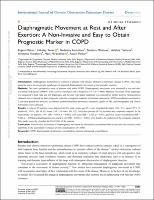Diaphragmatic Movement at Rest and After Exertion: A Non-Invasive and Easy to Obtain Prognostic Marker in COPD
Autor
Fecha
2022-05-05Enlace permanente
https://hdl.handle.net/11351/8047DOI
10.2147/COPD.S361235
ISSN
1178-2005
WOS
000797512200010
PMID
35547783
Palabras clave
EPOC; Disfunción diafragmática; Ecografía torácicaCitación recomendada
Mekov E, Yanev N, Kurtelova N, Mihalova T, Tsakova A, Yamakova Y, et al. Diaphragmatic Movement at Rest and After Exertion: A Non-Invasive and Easy to Obtain Prognostic Marker in COPD. Int J Chron Obstruct Pulmon Dis. 2022 May 5;17:1041–50.
Audiencia
Professionals
Este elemento aparece en las siguientes colecciones
- HVH - Articles científics [4471]
- VHIR - Articles científics [1751]
El ítem tiene asociados los siguientes ficheros de licencia:

 Área privada
Área privada Contacto
Contacto







